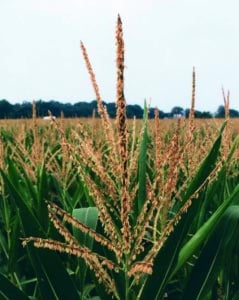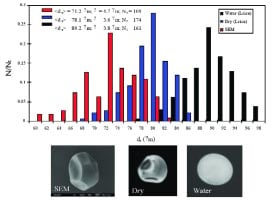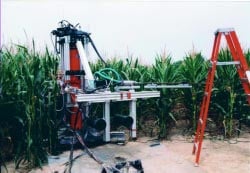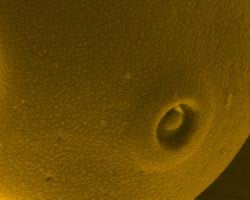A research center brings together like—and unlike—minds to apply expertise from a variety of viewpoints. Here are two centers that are bridging disciplines in the Whiting School and beyond.

During the drought of Summer 2002, Grace Brush and several of her enthusiastic graduate students trekked through the fields at the Wye Institute on the Eastern Shore. In this agricultural heart of Maryland, where irrigated corn fields stretch to the horizon, the professor and her students were setting up equipment to collect microscopic pollen grain samples from the air.
For many plants and trees, bees serve as the pollinators. But many others depend on the wind to reproduce. One corn plant can produce 2 million to 5 million grains of pollen, those tiny reproductive particles that waft along on their way to fertilizing neighboring corn plants. Corn pollen is among the heavier pollens, so it doesn’t usually travel as far as the lighter kinds, some of which can end up miles away.
To gather initial data for this research, Brush, who is a professor in the Whiting School’s Department of Geography and Environmental Engineering (DoGEE), and her team will conduct field tests at four sites in the Bay region. Among microscopic airborne particles, pollen grains are easily identifiable and so are serving as the primary particle they study.
Understanding the characteristics of atmospheric airflow is an important factor in determining how particles will travel, Brush explains. At the Wye Institute, the land is very flat. That’s why they chose this landscape as the first site for their study. “In terms of atmospheric condition, this area is probably simpler because you don’t have hills or other terrain, yet it’s still very complex due to the atmospheric turbulence,” says Brush.
“We started out by studying corn pollen, motivated by the fact that it’s important to know how far the pollen is being dispersed,” Brush explains. Along with collecting the grain samples from the air, the team measures the size and threedimensional shape of the pollen grains. “If that’s known,” she says, “then the behavior of the pollen grains in different atmospheric conditions can be simulated on the computer using direct numerical simulation.”
Dominating America’s food supply are the crops produced by agribusiness. With industrial agriculture’s widespread use of genetically modified plants has come a decrease in biodiversity. Where do those clouds of pollen from industrial agriculture end up? The question is of great concern to small farmers who grow heirloom varieties and organic produce. T

he aerosol transport of tiny particles is also of great interest to many other people today. Among them are those who want to know how widely anthrax spores can circulate, or whether a crop duster could be used to spread a deadly chemical.
Brush’s collecting of airborne pollen grain samples is just one aspect of the Whiting School’s wide-ranging $2.5 million Biocomplexity Research Project, which is sponsored by the National Science Foundation. This multidisciplinary project is aimed at studying biological aerosol transport in the atmosphere.
Brush is a paleobotanist whose research has focused on the Chesapeake Bay region. She is co-author of a general interest book about the processes that shaped this land: Discovering the Chesapeake: The History of an Ecosystem (Johns Hopkins University Press, 2001). Her co-authors, both from the Krieger School, are Philip D. Curtin, professor emeritus of History, and George W. Fisher, a professor of Earth and Planetary Sciences. In carefully studying many small things—among them, pollen, seeds, diatoms, charcoal, and chemicals in sediment cores— Brush is reconstructing the big picture of the estuary’s environmental history dating back 14,000 years.

On this Biocomplexity project, Brush is collaborating with DoGEE colleague and principal investigator Marc Parlange, along with four other Whiting School faculty members: Shiyi Chen, Charles V. Meneveau, and Joseph L. Katz from Mechanical Engineering and Roger G. Ghanem from Civil Engineering. All are also members of the Whiting School’s Center for Environmental and Applied Fluid Mechanics. The Biocomplexity researchers are developing specialized instrumentation to measure and quantify aerosol transport and conducting field and wind-tunnel experiments. They are also developing mathematical modeling to extrapolate the scale of their findings from microns to kilometers.
“The idea is to get measurements as precise as possible of the hydrodynamics of the grains of pollen so that you can use modeling and other techniques to predict what the behavior would be at a larger scale.”Grace Brush
Another aspect of their Biocomplexity research is using microscopy to photograph the pollen grains as they are emitted from plants. The researchers use the same technique to photograph this motion in wind-tunnel experiments. “The idea is to get measurements as precise as possible of the hydrodynamics of the grains of pollen so that you can use modeling and other techniques to predict what the behavior would be at a larger scale,” Brush says.

Ultimately, this five-year Biocomplexity research project will further the understanding of how airborne particles are dispersed. It may provide insights into air pollution, into how fungal spores carry disease to other plants, and into the ways in which ragweed pollen and other allergens make their way to our noses (those with hay fever will especially appreciate that aspect). The research is important in terms of the ongoing threat of losing plant diversity due to large-scale commercial farming methods, which reduce cross-pollination because only a few varieties are planted. And it’s important as well in terms of the need to isolate the pollen produced from genetically altered crops.
The Biocomplexity project has another benefit as well. It is producing a cross-pollination among engineering disciplines, a benefit that nicely fits into the overall goals of the research. “It’s very interesting,” Brush affirms, “because we’re all learning from each other.”
For more information, visit the Biocomplexity Research Project web site at pegasus.me.jhu.edu/~biocomplex/biocomplex.html




